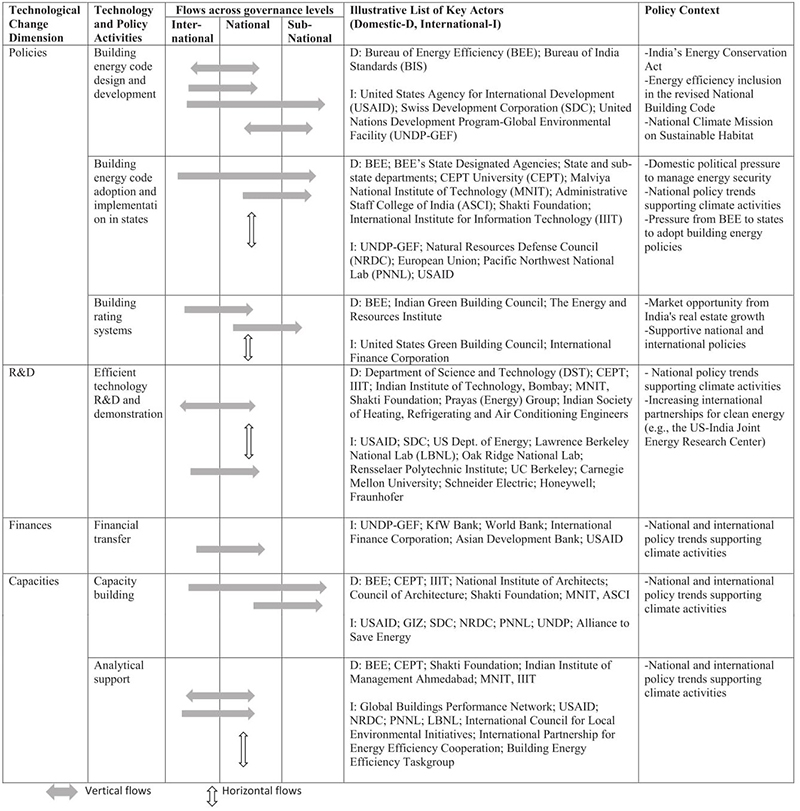Context
The current global architecture for climate policy and action comprises of a multiplicity of actors, organisations, and operational modalities that differ from those originally anticipated in the United Nations Framework Convention on Climate Change (UNFCCC). The climate change arena is now widely populated by activities that are often outside the formal auspices of UNFCCC, including initiatives that are public, private and civil society based, operating at various scales and thereby involving different levels of governance. This scenario raises two important questions:
- What are the implications of such a fragmented climate regime?
- And, more specifically, what are the opportunities and challenges this architecture poses for a low-carbon technology transition in developing countries, in keeping with international climate objectives?
The multi-level climate governance framework lays out two dimensions of action and influence to implement low-carbon strategies. One, is between national governments and regional and local actors. And the second, is the learning, knowledge transmission and cooperation across regions and organisational boundaries. Together, coordinated interactions within this structure have the potential to narrow policy and other ‘gaps’ to help address the problem of climate change.
What is this research about?
The built environment in India is ideal to study the potential of multi-level governance, particularly since its policies often draw on international activity and knowledge to implement locally-specific low carbon solutions. In 2010, buildings accounted for 32% of total global final energy use, and 35% of total energy consumption in India. This has made the buildings sector a fast-growing market for low-carbon energy technologies.
The paper titled Deploying Low-Carbon Technologies in Developing Countries: A view from India’s building sector, co-authored by Khosla, and published in Environmental Policy and Governance, discusses this issue by examining two inter-related questions:
- How do (or don’t) low-carbon technologies get transferred and deployed in India’s built environment?
- And what implications can be drawn from the Indian case for effective low-carbon technology development and transfer for developing countries?
How was the research conducted?
Empirically, the paper draws on interviews with experts within and outside government, data from official building energy documents, and insights from supporting literature. It also draws on author experiences of direct involvement in the sector. For instance, co-author Ajay Mathur headed India’s Bureau of Energy Efficiency for almost a decade, and Khosla worked alongside the state of Andhra Pradesh for two years on building energy code adoption.
Key findings
The paper examines the coverage and nature of the multilevel linkages within India’s built environment from 2000-2015. Authors examine if the multilevel climate architecture can be leveraged to support technological change for desired outcomes in Indian buildings.
Table 1 presents a collation of key building energy technology activities and actors, and their respective governance levels. The table lists the different activities that comprise technological change: technology research and development (R&D); financial transfer to assist different stages of the technology cycle; capacity building and analytical support; policy designs and implementation.

Table 1. Activity map of low-carbon technological change in India’s buildings (2000-2015)
Three patterns characterise the nature of technological change in India’s low-carbon buildings.
- First, most activities flow through vertical linkages in a top-down (international → national → subnational) direction, as opposed to international processes and outcomes being shaped by national or subnational level activities. States or subnational bodies thereby seldom serve as ‘laboratories of experimentation’ or pioneers of policy initiation.
- Second, and a consequence of the largely top-down nature of activities, is the profusion of international actors engaging with this space in India. This international linkage is usually mediated by domestic actors, making it collaborative in scope. The expertise from various bilateral, multilateral and strategic partnerships, and additional groups has played an important role over the last decade and a half, and in most cases work is co-produced with local experts, civil society partners and national/state governments.
- Third, the activity patterns in Table 1 demonstrate a focus on the downstream stages of the technological cycle, i.e. on deployment. However, the other dimensions underlying technological change – technology R&D and financial transfer – have been less present in Indian buildings, even though both are important to advance technologies (the US–India R&D collaboration being a recent exception). This observation of a limited focus on the upstream parts (research, product development) of the technology cycle is consistent with the larger landscape of international collaborative and support activities.
Together, these patterns demonstrate the potential but also the limitations of working with the linkages between and across governance levels. The paper further discusses three factors that collectively help explain these patterns: the particularities of India’s federal structure; the constraints of capacity, which is typical of developing countries; and the growing policy linkages between energy and climate change stemming from the global climate debate. This discussion informs the subsequent policy recommendations for low-carbon technology transfer in developing countries more broadly.
Policy recommendations
- Adopting a ‘Need’-Driven Approach – Most developing countries prioritise economic and social development over investments in expensive low-carbon technologies. Technology transfer thus needs to be constructed around a collaborative and ongoing local assessment process, driven by developed and developing countries. Examples are green building designs that take into account local climatic conditions and occupant use patterns or policy delivery models that consider behaviour norms or financial realities of consumers. Engagement between developed countries and networks of local users, and with their private sector is equally relevant. Better country understanding of recipient priorities and capabilities (technologies, finance and knowledge), with ongoing local inputs, will be fruitful for international actors working in developing countries and also increase domestic buy-in.
- Differentiated Approach to Capacity Building: Most developing countries struggle with questions of capacity. While international funds often focus on capacity projects, these efforts rarely translate to a domestic critical mass. It is thus important to understand the kinds of capacity needed in order to build them – for instance, studies have shown that crucial ingredients of technology transfer are found rarely in ‘hardware’, but rather in people-embodied knowledge. More specifically, the research findings of this paper suggest that greater emphasis needs to be placed on building operational, strategic and organisational capacities.
- Strengthen Linkages and Integrate Agendas across Governance Levels: Developing countries can strengthen linkages and respective agendas across governance levels – to enable appropriate flows of knowledge regarding technology needs, possible solutions and delivery mechanisms, and allow resources to reach where they are most needed. For instance, developing countries can leverage the growing profusion of initiatives targeted at climate mitigation by investing in better coordination with international fora, communicating their specific needs and appropriately shaping the international agenda. The linkages between the national and local levels are equally crucial, especially since the effectiveness of any climate programme ultimately depends on outcomes on the ground.
The publisher page from where the full paper can be purchased can be accessed here.
For a copy of the publication, contact climate.initiative.cpr@gmail.com.


